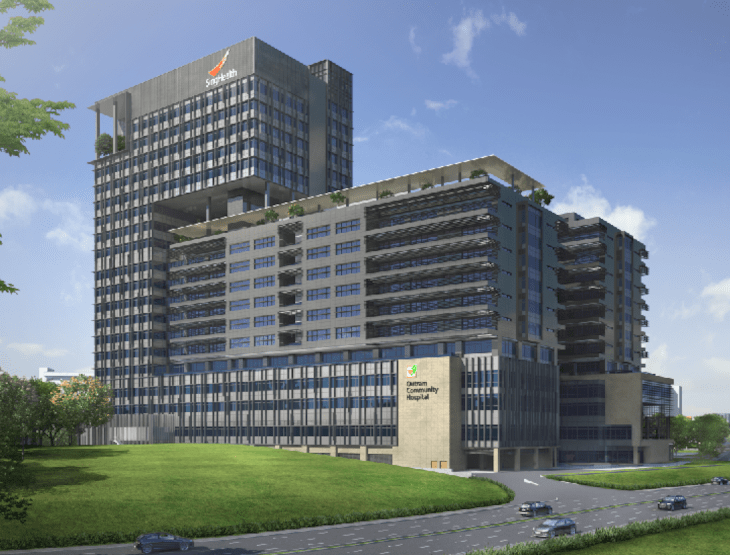Outram Community Hospital
Automated storage and picking solution streamlines the medical supplies at the mega hospital in Singapore
In 2020, Outram Community Hospital, which was newly established on a vast site in the center of Singapore, began installing automated equipment along with the construction of the hospital, and built a system consisting of case-type ASRS and high-speed transport vehicle for the hospital's supply management department and pharmacy. By automating storage and management, we have improved work efficiency and reduced labor in the tight medical field.
-

Storage area of the hospital pharmacy. A high-speed transport vehicle circles from receiving/shipping and picking areas to the inbound/outbound of ASRS, handling inbound/outbound load.
-

The storage area of the goods management department. As in the hospital pharmacy, a high-speed transport vehicle circles a looped track that runs from the side to the front of the ASRS.
Singapore's healthcare system is highly regarded worldwide, ranking second in efficiency after Hong Kong (according to Bloomberg*1) and first in Asia in the number of hospitals with JCI certification*2, making it one of the world's most advanced healthcare systems.
Singapore General Hospital (SGH), the country's largest general hospital with the longest history, operates three community hospitals that provide community-based medical care. One of them, Outram Community Hospital (OCH), was newly established in 2019 within the SGH premises so that patients who have undergone surgery or treatment at SGH can seamlessly receive rehabilitation and palliative care.
OCH is a large hospital with approximately 550 beds, and in order to improve the efficiency of goods handling, such as storage and picking of medical supplies and medicines handled in the hospital, the decision was made to install automated equipment, including case-type ASRS, in the hospital's goods management department and pharmacy, respectively. After the construction of the hospital, the installation of the equipment began, and it became operational in April 2020.
- *1Health Care Efficiency Score in 56 Economies(Bloomberg Health Efficiency Index)
- *2JCI (Joint Commission International) certification is a certification organization that evaluates medical facilities from a third-party perspective by an international non-profit organization.
-

OCH, with a total floor area of 146,000 square meters, is connected to SGH by a connecting bridge.
-

There are six goods-to-person picking stations in the hospital pharmacy.
Installed case-type ASRS at two locations in the hospital to improve storage and processing capacity.
The case-type ASRS installed in the hospital pharmacy is equipped with four cranes and has a storage capacity of 1,416 cases. As load handling system for inbound and outbound shipments, four loop-type high-speed transport vehicles are arranged to enter the automated warehouse with foldable containers containing chemicals. Once orders come in and the containers are retrieved, they are transported to the goods-to-person picking station in the picking area. The retrieved containers pause at the lower level of the station, and the operator picks up the quantity indicated by the indicator on the conveyor and puts it into the container for collection at the upper level. This enables picking work to be performed in fixed positions, improving picking accuracy.
The system also incorporates an RFID solution. The RFID tags attached to the containers are automatically read by the readers when the containers are stored and retrieved for real-time inventory control.
On the other hand, case-type ASRS with three cranes and a storage capacity of 1,918 cases has been installed in the goods management department. This is where medical consumables used in medical treatment, such as gauze, medical tape and masks, are stored. As with the hospital pharmacy, five loop-type high-speed transport vehicles are arranged as a load handling system for storage and retrieval ASRS. Containers are transported from the inbound/outbound station located on the side of the ASRS and are then stored into the ASRS. For picking, U-shaped conveyors are installed at four stations. Containers that have been ordered for delivery are transported to the station by a high-speed transport vehicle, picked on the conveyor, inspected by weighing, placed in a container for collection, and transported to the required department by Shuttle cart.
With the spread of new coronavirus infections, the storage facilities, which require little human intervention, and the picking system, which can be done by a small number of people in a short period of time, have led to improved processing capacity, efficiency, and labor savings in the tight medical field. Since this is the first automated facility for in-hospital logistics in a hospital run by SGH, the hospital will be the flagship of the project, and we intend to expand the system to other hospitals.
At the picking station of the goods management department, the goods are inspected by weighing before being put into containers for collection.
Contact Us
For product inquiries, please reach out to us via our Contact Us page.
Contact UsContact Us
For product inquiries, please reach out to us via our Contact Us page.
Contact Us

